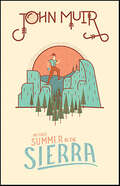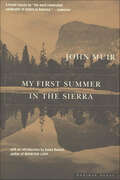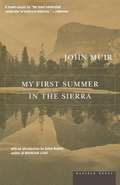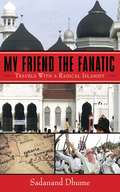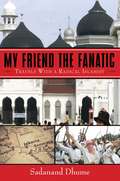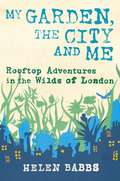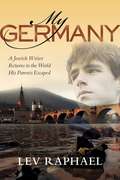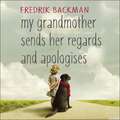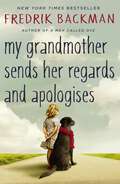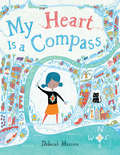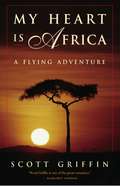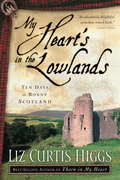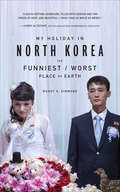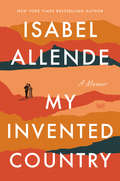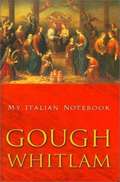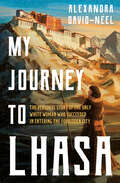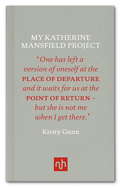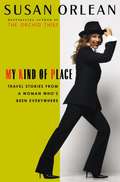- Table View
- List View
My Favourite Goodbye: A touching, uplifting and romantic tale by the #1 bestselling author
by Sheila O'FlanaganSheila O'Flanagan's MY FAVOURITE GOODBYE is a delicious novel about finding love in unexpected places - not to be missed by readers of Veronica Henry and Freya North. Ash O'Halloran is happy with her futon, her flat, her cat and her job as a party caterer. She doesn't do impulsive. She is absolutely, perfectly in control of her single woman's life. And if she can't have relationships without complications - then she's content to carry on as she is. Ms Self-Contained. But when she's employed to cook the supper over which Dan Morland plans to propose to his girlfriend, suddenly she becomes party to someone else's relationship - in all its tangled, heart-breaking complexity. And, as she watches Dan struggling to sort out the mess his emotions have got him into, Ash starts to realise she's not Ms Invulnerable after all...What readers are saying about My Favourite Goodbye: 'An absolutely excellent book - I don't think I've read a more touching story since' Goodreads reviewer, 5 stars'I have read a couple of Sheila O'Flanagan's books already but this one is by far the best. I wanted to read it all in one go but I just didn't want it to end so like a delicious bar of chocolate I allowed myself a bit at a time' Amazon reviewer, 5 stars'What a delightful read! I cannot imagine anyone not enjoying this charming, light-hearted and humorous book' Amazon reviewer, 5 stars
My Favourite Goodbye: A touching, uplifting and romantic tale by the #1 bestselling author
by Sheila O'FlanaganSheila O'Flanagan's MY FAVOURITE GOODBYE is a delicious novel about finding love in unexpected places - not to be missed by readers of Veronica Henry and Freya North. Ash O'Halloran is happy with her futon, her flat, her cat and her job as a party caterer. She doesn't do impulsive. She is absolutely, perfectly in control of her single woman's life. And if she can't have relationships without complications - then she's content to carry on as she is. Ms Self-Contained. But when she's employed to cook the supper over which Dan Morland plans to propose to his girlfriend, suddenly she becomes party to someone else's relationship - in all its tangled, heart-breaking complexity. And, as she watches Dan struggling to sort out the mess his emotions have got him into, Ash starts to realise she's not Ms Invulnerable after all...What readers are saying about My Favourite Goodbye:'An absolutely excellent book - I don't think I've read a more touching story since' Goodreads reviewer, 5 stars'I have read a couple of Sheila O'Flanagan's books already but this one is by far the best. I wanted to read it all in one go but I just didn't want it to endso like a delicious bar of chocolate I allowed myself a bit at a time' Amazon reviewer, 5 stars'What a delightful read! I cannot imagine anyone not enjoying this charming, light-hearted and humorous book' Amazon reviewer, 5 stars
My Favourite Goodbye: A touching, uplifting and romantic tale by the #1 bestselling author
by Sheila O'FlanaganSheila O'Flanagan's MY FAVOURITE GOODBYE is a delicious novel about finding love in unexpected places - not to be missed by readers of Jamie Beck and Liane Moriarty. Ash O'Halloran is happy with her futon, her flat, her cat and her job as a party caterer. She doesn't do impulsive. She is absolutely, perfectly in control of her single woman's life. And if she can't have relationships without complications - then she's content to carry on as she is. Ms Self-Contained. But when she's employed to cook the supper over which Dan Morland plans to propose to his girlfriend, suddenly she becomes party to someone else's relationship - in all its tangled, heart-breaking complexity. And, as she watches Dan struggling to sort out the mess his emotions have got him into, Ash starts to realise she's not Ms Invulnerable after all...(P)2018 Headline Publishing Group Ltd
My First Book of Travel (My Cool Family)
by Robyn WallFamilies who love to travel are the stars of this hip board book featuring babies and toddlers and their families as they explore the world. From the My Cool Family board book series.Overseas or coast to coast, I love trips with you the most!Little ones whose families love to pack a bag and hop on a plane or train will smile and giggle at this sweet and stylish board book that celebrates the world of travel, sure to delight all families with a wanderlust. It's the perfect baby shower and first birthday book for babies with the coolest families.Also available in the My Cool Family series: My First Book of TattoosMy First Book of BeardsMy First Book of Coffee
My First Summer in the Sierra
by John MuirConsidered one of the patron saints of twentieth-century environmental activity, John Muir's appeal to modern readers is that he not only explored the American West but also fought for its preservation. My First Summer in the Sierra is Muir’s account of his adventures and observations while working as a shepherd in the Yosemite Valley, which later became Yosemite National Park as a direct result of Muir’s writings and activism. Muir’s heartfelt and often humorous descriptions of his first summer spent in the Sierra will captivate and inspire long-time fans and novice naturalists alike.
My First Summer in the Sierra (Mint Editions (the Natural World) Ser.)
by John MuirFrom the photographer who brought Thoreau's Walden and Cape Cod to life comes a new work combining classic literature with brand-new photography. This time, Scot Miller takes on the seminal work of John Muir, My First Summer in the Sierra. The book details Muir's first extended trip to the Sierra Nevada in what is now Yosemite National Park, a landscape that entranced him immediately and had a profound effect on his life. The towering waterfalls, natural rock formations, and abundant plant and animal life helped Muir develop his views of the natural world, views that would eventually lead him to push for the creation of the national parks. My First Summer in the Sierra is illustrated with Miller's stunning photographs, showcasing the dramatic landscape of the High Sierra plus John Muir's illustrations from the original edition and several previously unpublished illustrations from his 1911 manuscript. The publication of My First Summer in the Sierra inspired many to journey there, and this newly illustrated edition will surely inspire many more. This book is being published in collaboration with Yosemite Conservancy and, for each copy sold, Scot Miller is making a donation to Yosemite Conservancy. My First Summer in the Sierra won the National Outdoor Book Award.
My First Summer in the Sierras
by John MuirMuir kept this journal on his first extended trip to Yosemite in 1869. Here he faithfully recorded his impressions of the dazzling animal and plant life he encountered in the magnificent Sierra.
My Friend the Fanatic
by Sadanand DhumeMy Friend the Fanatic is a portrait of the world's most populous Muslim country, Indonesia, and the fourth most populous nation in the World. A nation once synonymous with tolerance that now finds itself in the midst of a profound shift toward radical Islam. The portrait is painted through the travels of a pair of unlikely protagonists. Sadanand Dhume, the author, is a foreign correspondent-a Princeton-educated Indian atheist with a fondness for literary fiction and an interest in economic development. His companion, Herry Nurdi, is a young Islamist who hero worships Osama bin Laden. Their travels span mosques and discotheques, prison cells and dormitories, sacred volcanoes and temple ruins.
My Friend the Fanatic: Travels with a Radical Islamist
by Sadanand DhumeA nation once synonymous with tolerance, Indonesia, the fourth-most populated country in the world and its most populous Muslim country, now finds itself in the midst of a profound shift toward radical Islam. Sadanand Dhume, a Princeton-educated Indian atheist with a fondness for literary fiction and an interest in economic development, travels across Indonesia to find out how a society goes from broad inclusiveness to outspoken intolerance in the space of a generation. His traveling companion is Harry Nurdi, a young Islamist who hero-worships the late Osama bin Laden and sympathizes with the Taliban. Their travels span mosques and discotheques, prison cells and dormitories, sacred volcanoes and temple ruins. Over time, they forge an uneasy friendship that offers a firsthand look into the crucible of radical Islam’s future. With a new preface by the author detailing what has happened in Indonesia since the book’s initial publication, My Friend the Fanatic is the story of an alternately disturbing, amusing, and poignant journey that illuminates one of the most pressing issues of our time.
My Garden, the City and Me: Rooftop Adventures in the Wilds of London
by Helen BabbsHelen Babbs is a self-proclaimed city girl who lives on the second floor of a flat in a chaotic corner of London. An urge to find more green in the city and a stronger connection to the natural world leads her to create her first garden, an organic edible garden on her rooftop. This year-long adventure is the story behind My Garden, the City and Me. The journey begins in the dark of winter, where Babbs finds herself at a seed swap on a February morning, seduced more by packaging than by any true understanding of the plants. As the year progresses, Babbs revels in failures, like waking up bleary eyed and stomping on her seed starts, and triumphs like her summer-ending dinner party made with homegrown produce. Along the way she discovers “that I like gardening in my pajamas and that growing something from seed, watching it develop and then eating its fruits is truly joyful. I’ve daydreamed out there and entertained out there. It’s the force behind new friendships that I’ve forged. The garden has opened my eyes to a whole new side of London and urban living.”My Garden, the City and Me is a lyrical narrative about a twenty-something in search for a bit of wild in her city. The journey is charming, honest, and steeped in the lore of London, a city equally known for its gardens and its grit. In the end Babbs has achieved a new perspective on what it means to live green in the city she loves.
My Germany: A Jewish Writer Returns to the World His Parents Escaped
by Lev RaphaelLev Raphael grew up loathing everything German. A son of Holocaust survivors, haunted by his parents' suffering and traumatic losses under Nazi rule, he was certain that Germany was one place in the world he would never visit. Those feelings shaped his Jewish and gay identity, his life, and his career. Then the barriers of a lifetime began to come down, as revealed in this moving memoir. After his mother's death, while researching her war years, Raphael found a distant relative living in the very city where she had been a slave laborer. What would he learn if he actually traveled to the place where his mother had found freedom and met his father? Not long after that epochal trip, a German publisher bought several of his books for translation. Raphael was launched on book tours in Germany, discovering not so much a new Germany, but a new self: someone unafraid to face the past and transcend it.
My Grandmother Sends Her Regards and Apologises
by Fredrik BackmanA must-read for fans of Rachel Joyce's The Unlikely Pilgrimage of Harold Fry and Maria Semple's Where'd You Go, BernadetteHeartbreaking and hilarious in equal measure, by the author of the New York Times bestselling phenomenon A Man Called Ove will charm and delight anyone who has ever had a grandmother. Everyone remembers the smell of their grandmother's house. Everyone remembers the stories their grandmother told them.But does everyone remember their grandmother flirting with policemen? Driving illegally?Breaking into a zoo in the middle of the night? Firing a paintball gun from a balcony in her dressing gown?Seven-year-old Elsa does.Some might call Elsa's granny 'eccentric', or even 'crazy'. Elsa calls her a superhero. And granny's stories, of knights and princesses and dragons and castles, are her superpower. Because, as Elsa is starting to learn, heroes and villains don't always exist in imaginary kingdoms; they could live just down the hallway.As Christmas draws near, even the best superhero grandmothers may have one or two things they'd like to apologise for. And, in the process, Elsa can have some breath-taking adventures of her own . . .(P)2015 Hodder & Stoughton
My Grandmother Sends Her Regards and Apologises: From the bestselling author of A MAN CALLED OVE
by Fredrik BackmanA must-read for fans of Rachel Joyce's The Unlikely Pilgrimage of Harold Fry and Maria Semple's Where'd You Go, Bernadette'A touching, sometimes funny, often wise portrait of grief.' Kirkus Heartbreaking and hilarious in equal measure, by the author of the New York Times bestselling phenomenon A Man Called Ove will charm and delight anyone who has ever had a grandmother. Everyone remembers the smell of their grandmother's house. Everyone remembers the stories their grandmother told them.But does everyone remember their grandmother flirting with policemen? Driving illegally?Breaking into a zoo in the middle of the night? Firing a paintball gun from a balcony in her dressing gown?Seven-year-old Elsa does.Some might call Elsa's granny 'eccentric', or even 'crazy'. Elsa calls her a superhero. And granny's stories, of knights and princesses and dragons and castles, are her superpower. Because, as Elsa is starting to learn, heroes and villains don't always exist in imaginary kingdoms; they could live just down the hallway.As Christmas draws near, even the best superhero grandmothers may have one or two things they'd like to apologise for. And, in the process, Elsa can have some breath-taking adventures of her own . . .
My Grandmother Sends Her Regards and Apologises: From the bestselling author of A MAN CALLED OVE
by Fredrik BackmanA must-read for fans of Rachel Joyce's The Unlikely Pilgrimage of Harold Fryand Maria Semple's Where'd You Go, Bernadette'A touching, sometimes funny, often wise portrait of grief.' Kirkus Heartbreaking and hilarious in equal measure, by the author of the New York Times bestselling phenomenon A Man Called Ove will charm and delight anyone who has ever had a grandmother. Everyone remembers the smell of their grandmother's house. Everyone remembers the stories their grandmother told them.But does everyone remember their grandmother flirting with policemen? Driving illegally?Breaking into a zoo in the middle of the night? Firing a paintball gun from a balcony in her dressing gown?Seven-year-old Elsa does.Some might call Elsa's granny 'eccentric', or even 'crazy'. Elsa calls her a superhero. And granny's stories, of knights and princesses and dragons and castles, are her superpower. Because, as Elsa is starting to learn, heroes and villains don't always exist in imaginary kingdoms; they could live just down the hallway.As Christmas draws near, even the best superhero grandmothers may have one or two things they'd like to apologise for. And, in the process, Elsa can have some breath-taking adventures of her own . . .
My Heart Is a Compass
by Deborah MarceroIn this celebration of the power of imagination, a creative girl on a mission to bring something new to the world becomes a storyteller and inventor of intricately detailed maps. p.p1 {margin: 0.0px 0.0px 0.0px 0.0px; font: 15.0px Calibri; -webkit-text-stroke: #000000} span.s1 {font-kerning: none} Rose's heart is set on discovering something that's never been found. She just doesn't know where to find it. So she sets off on a wondrous journey, bounding from one spectacular world to the next. Her only guides are a set of maps drawn from her own imagination and her heart's desire to explore new and exciting worlds. In this moving story of a trailblazing spirit, Rose follows her compass, and explores her creativity in a one-of-a-kind search through a collection of intricate maps that readers will love to get lost in.
My Heart is Africa: A Flying Adventure
by Scott GriffinIn 1996, successful businessman and certified pilot, Scott Griffin, decided to break from the comfortable routine of his life to go work for the Flying Doctors Service, an African organization that flies doctors to remote areas to administer medical assistance. Griffin also made the daring decision to fly his small, single-engine Cessna 180 solo from Canada to Africa and back again. My Heart is Africa is the engaging, personal story of Griffin’s two-year aviation adventure throughout Africa. Facing storms, equipment problems, fuel shortages and isolation, Griffin successfully made his way to Kenya – little did he know, his harrowing flight over the Atlantic was only the beginning of his adventure. Once in Africa, Griffin circumnavigated the continent, flying over deserts, mountains and jungles both as a medical volunteer and tourist. Throughout his journey – which included being arrested and crashing, then re-crashing, his plane – Griffin discovered the heartrending humanity and beauty of Africa. My Heart is Africa is an absorbing adventure story, but it is also the story of Africa – its problems and people, its landscapes and limitations, its culture and courage. Griffin’s intrepid flying odyssey not only takes the reader on a journey across Africa but into the lives of all the doctors, nurses, aid workers and eccentric characters that crossed his path along the way. My Heart is Africa is a fascinating and gripping account of one man’s quest to push beyond his personal limits in order to explore and experience a new way of life.
My Heart's in the Lowlands: Ten Days in Bonny Scotland
by Liz Curtis Higgs“Let’sgo,shall we? Just the two of us?” “I consider Galloway the country’s best kept secret: a place where time holds its breath, where ancient ruins dot the countryside in moss-covered splendor, where the natives are friendly and tourists are few, only because they don’t know what they’re missing. “So, ten days in bonny Scotland. You’ll join me, aye?” –fromMy Heart’s in the Lowlands Best-selling novelist Liz Curtis Higgs invites you to take an entertaining journey through the South West of Scotland, known as Dumfries and Galloway. Without crossing the pond, changing time zones, or driving on the left side of the road, you’ll explore quaint villages and crumbling castles, old bookshops and charming tearooms in the delightful company of a guide whose love for this quiet nook of Scotland illuminates every page. The verdant hills and glens of the Lowlands are awash in history, rich with culture, and peopled with engaging characters. The setting for Higgs’s acclaimed series of historical novels, Dumfries and Galloway also serves as her home away from home. Her decade-long love affair with this unique area of the world, combined with her award-winning storytelling skills, makes her the ideal armchair travel companion. Warm, personal, and deeply evocative,My Heart’s in the Lowlandstransports you to an unforgettable corner of Scotland that will lay claim to your heart forever. Liz Curtis Higgsis the best-selling author of 25 books, including her Scottish historical novelsThorn in My Heart, Fair Is the Rose, Whence Came a Prince,andGrace in Thine Eyes. She is currently writing her fifth historical novel,Here Burns My Candle. From the Trade Paperback edition.
My Holiday in North Korea: The Funniest/Worst Place on Earth
by Wendy E. Simmons&“You remember Eat, Pray, Love and Under the Tuscan Sun? Yeah, this really isn&’t like those. It&’s better&” (San Francisco Chronicle). Most people want out of North Korea. Wendy Simmons wanted in. In My Holiday in North Korea: The Funniest/Worst Place on Earth, Wendy shares a glimpse of North Korea as it&’s never been seen before. Even though it&’s the scariest place on Earth, somehow Wendy forgot to check her sense of humor at the border. But Wendy&’s initial amusement and bewilderment soon turned to frustration and growing paranoia. Before long, she learned the essential conundrum of &“tourism&” in North Korea: Travel is truly a love affair. But, just like love, it&’s a two-way street. And North Korea deprives you of all this. They want you to fall in love with the singular vision of the country they&’re willing to show you and nothing more. Through poignant, laugh-out-loud essays and ninety-two never-before-published color photographs of North Korea, Wendy chronicles one of the strangest vacations ever. Along the way, she bares all while undergoing an inner journey as convoluted as the country itself. &“Much of the humor and poignancy comes from the absurdity of a fun-loving free spirit taking a vacation that&’s more rigidly scripted and controlled than a presidential motorcade . . . Simmons&’ photos—including an eerie image of a classroom full of schoolgirls playing accordions—further illustrate the bizarre nature of a country that, whether for good or bad, has been carefully controlled for generations.&” —San Francisco Chronicle &“An irresistible read . . . A rare and fascinating look at the tourist&’s North Korea in a work that is humorous, appalling, and very sad. A highly recommended and revealing glimpse into a secretive land.&” —Library Journal
My Invented Country: A Nostalgic Journey Through Chile
by Isabel AllendeA highly personal memoir of exile and homeland by bestselling author Isabel AllendeIn My Invented Country Isabel Allende evokes the magnificent landscapes of her country, a charming, idiosyncratic Chilean people with a violent history and indomitable spirit, and the politics, religion, myth and magic of her homeland that she carries with her even today. The book circles around two life-changing moments. The assassination of her uncle, Salvador Allende Gossens, on September 11, 1973, sent her into exile and transformed her into a literary writer. And the terrorist attacks of September 11, 2001, on her adopted homeland, the United States, brought forth from Allende an overdue acknowledgment that she had indeed left home. My Invented Country, whose structure mimics the workings of memory itself, ranges back and forth across that distance accrued between the author’s past and present lives. It speaks compellingly to immigrants, and to all of us, who try to retain a coherent inner life in a world full of contradictions.
My Journey Back to Eden: My Life and Times among the Desert Fathers
by Mark GruberWhen Gruber arrives in Egypt to study the Coptic monasteries, he finds that he has sent his money to Egypt's national bank--a bank with many branches and no connectedness. Since he is almost broke, he immediately begins to live the life of an Egyptian, where building a castle in the sand can cause trouble, and knowing when to act as anthropologist versus Catholic priest is confounding. Gruber weaves religious history, politics, personal prayers, (which are beautiful) and descriptions of monastery life into a captivating journal. This is a lively book which is informative, interesting, and inspirational.
My Journey to Lhasa: The Personal Story of the only White Woman Who Succeeded in Entering the Forbidden City
by Alexandra David-NéelThis early-twentieth-century adventure travel memoir by a female explorer is &“the sort of thriller yarn that keeps you up all night and is too soon over&” (Ms.). In this extraordinary mix of travelogue and autobiography, Madame Alexandra David-Néel details her 1923 expedition to Lhasa as the first Western woman to enter Tibet&’s Forbidden City. Recounting how she traveled with her adopted son, posing as a beggar and relying on her fluency in Tibetan dialects and culture, David-Néel relates a story of survival among harsh conditions and the ever-present danger of being discovered as a white woman, as well as her triumphant meeting with the Dalai-Lama. A compelling narrative by an adventurer, explorer, and passionate student of Buddhism, My Journey to Lhasa is an inspiring work of travel literature by a remarkable woman. &“My Journey to Lhasa . . . involves us intensely in a world that no longer exists—that of free Tibet. . . . [David-Néel&’s] descriptions of the landscape are fervent and her understanding of the Tibetans admirably unsentimental. Her Tibet is not at all the philosophers&’ kingdom of Lost Horizon; it is a fierce . . . frequently dangerous place, where she had to exercise the utmost ingenuity to survive.&” —The New York Times Book Review &“A lively account . . . and a classic portrait of Tibet, its region, and its people.&” —The Bloomsbury Review &“David-Néel was indisputably a fearless traveler, a rogue&’s rogue. Her account has the power to awe even today.&” —Outside &“As a traveler, she has performed a brilliant feat.&” —New Statesman
My Katherine Mansfield Project
by Kirsty GunnIn 2009, Kirsty Gunn returned to spend the winter in her hometown of Wellington, New Zealand, also the place where Katherine Mansfield grew up. In this exquisitely written "notebook," which blends memoir, biography, and essay, Gunn records that winter-long experience and the unparalleled insight it allowed her into Mansfield's fiction. Gunn explores the idea of home and belonging--and of the profound influence of Mansfield's work on her own creative journey. She asks whether it is even possible to "come home"--and who are we when we get there?
My Kind of Place: Travel Stories from a Woman Who's Been Everywhere
by Susan OrleanSusan Orlean has been called "a national treasure" by The Washington Post and "a kind of latter-day Tocqueville" by The New York Times Book Review. In addition to having written classic articles for The New Yorker, she was played, with some creative liberties, by Meryl Streep in her Golden Globe Award-winning performance in the film Adaptation. Now, in My Kind of Place, the real Susan Orlean takes readers on a series of remarkable journeys in this uniquely witty, sophisticated, and far-flung travel book.
My Little French Kitchen: Over 100 Recipes from the Mountains, Market Squares, and Shores of France
by Rachel KhooTravel through the French countryside with the author of The Little Paris Kitchen—and find one hundred recipes from Brittany Bouillon to Tropezienne Tartlet.Through her cookbook and BBC television show The Little Paris Kitchen, Rachel Khoo became known for her Parisian lifestyle, fashion sense—and delicious recipes. In My Little French Kitchen, Rachel leaves Paris and travels to the mountains, villages, and shores of France, sampling regional specialties and translating them into more than one hundred recipes. With extensive photographs, as well as dozens of Rachel’s own hand-drawn illustrations, this is the perfect cookbook for foodies and Francophiles hungry for more fresh takes on French classics.Praise for Rachel Khoo’s cookbooks:“Quirky twists on classic dishes.” —Easy Living“Excellent . . . stylish, tempting, and just plain fun.” —Publishers Weekly (starred review)



